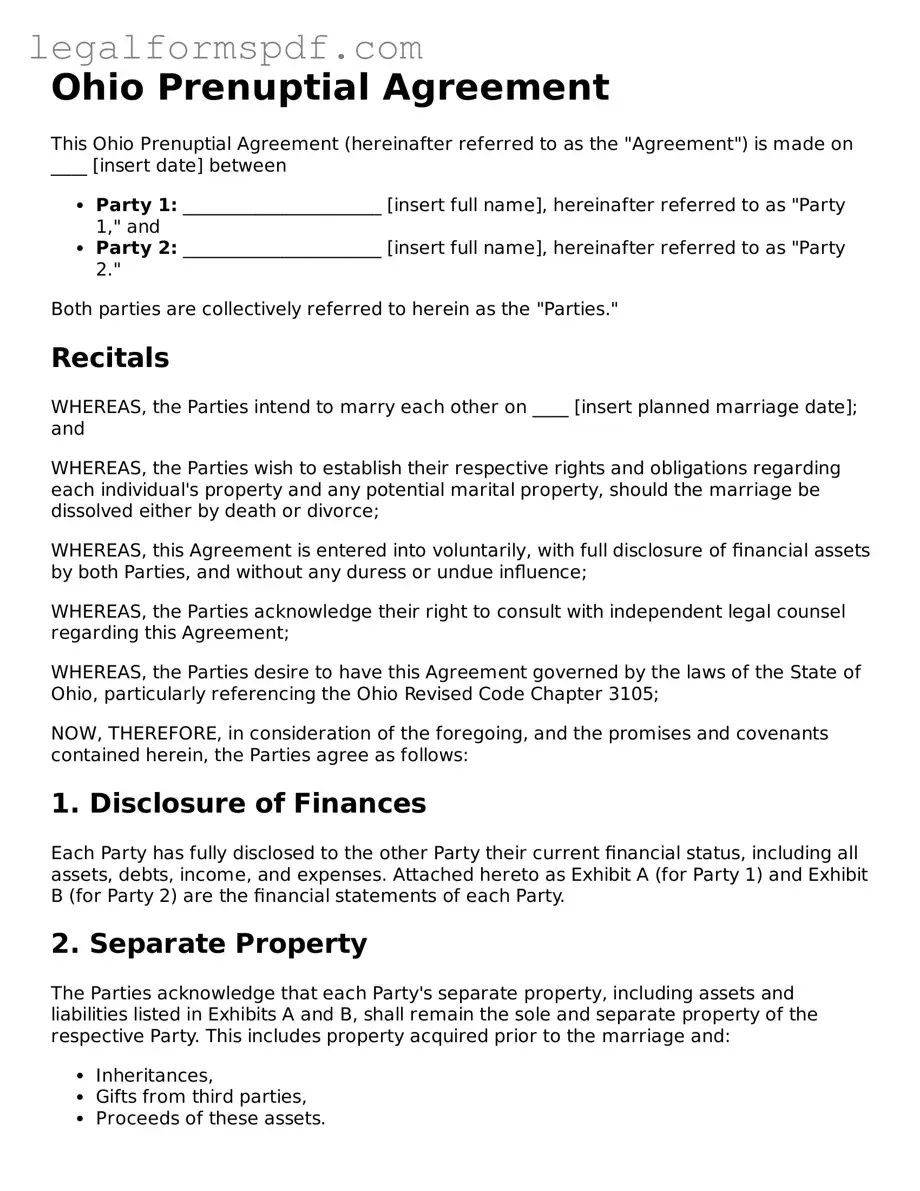Ohio Prenuptial Agreement
This Ohio Prenuptial Agreement (hereinafter referred to as the "Agreement") is made on ____ [insert date] between
- Party 1: ______________________ [insert full name], hereinafter referred to as "Party 1," and
- Party 2: ______________________ [insert full name], hereinafter referred to as "Party 2."
Both parties are collectively referred to herein as the "Parties."
Recitals
WHEREAS, the Parties intend to marry each other on ____ [insert planned marriage date]; and
WHEREAS, the Parties wish to establish their respective rights and obligations regarding each individual's property and any potential marital property, should the marriage be dissolved either by death or divorce;
WHEREAS, this Agreement is entered into voluntarily, with full disclosure of financial assets by both Parties, and without any duress or undue influence;
WHEREAS, the Parties acknowledge their right to consult with independent legal counsel regarding this Agreement;
WHEREAS, the Parties desire to have this Agreement governed by the laws of the State of Ohio, particularly referencing the Ohio Revised Code Chapter 3105;
NOW, THEREFORE, in consideration of the foregoing, and the promises and covenants contained herein, the Parties agree as follows:
1. Disclosure of Finances
Each Party has fully disclosed to the other Party their current financial status, including all assets, debts, income, and expenses. Attached hereto as Exhibit A (for Party 1) and Exhibit B (for Party 2) are the financial statements of each Party.
2. Separate Property
The Parties acknowledge that each Party's separate property, including assets and liabilities listed in Exhibits A and B, shall remain the sole and separate property of the respective Party. This includes property acquired prior to the marriage and:
- Inheritances,
- Gifts from third parties,
- Proceeds of these assets.
3. Marital Property
Property acquired by either Party during the marriage will be considered marital property, subject to division, except as may otherwise be agreed upon hereinafter.
4. Rights and Obligations Upon Separation, Divorce, or Death
Upon the dissolution of marriage by separation, divorce, or death of a Party, the rights to property and the division thereof shall be governed by the terms of this Agreement.
5. Amendments and Termination
This Agreement may only be amended or terminated by a written document signed by both Parties.
6. Governing Law
This Agreement shall be governed by and construed in accordance with the laws of the State of Ohio, without giving effect to any choice or conflict of law provision or rule.
7. Entire Agreement
This Agreement constitutes the entire agreement between the Parties relating to the subject matter herein and supersedes all prior agreements, understandings, negotiations, and discussions, whether oral or written, of the Parties.
IN WITNESS WHEREOF, the Parties have executed this Agreement on the date first written above.
_________________________________________
Signature of Party 1
_________________________________________
Signature of Party 2
Witnessed by:
_________________________________________
Signature of Witness
Date: ______________________
